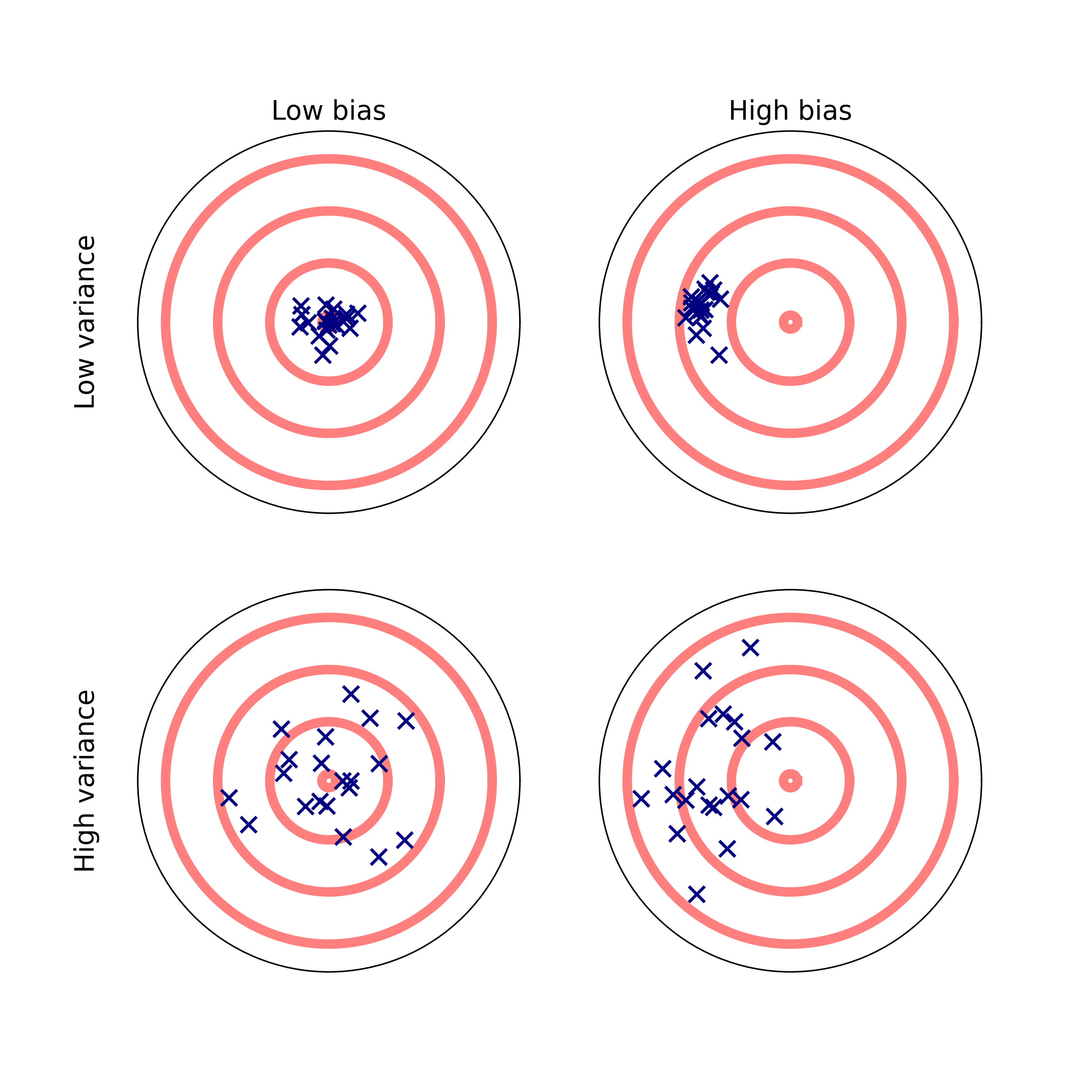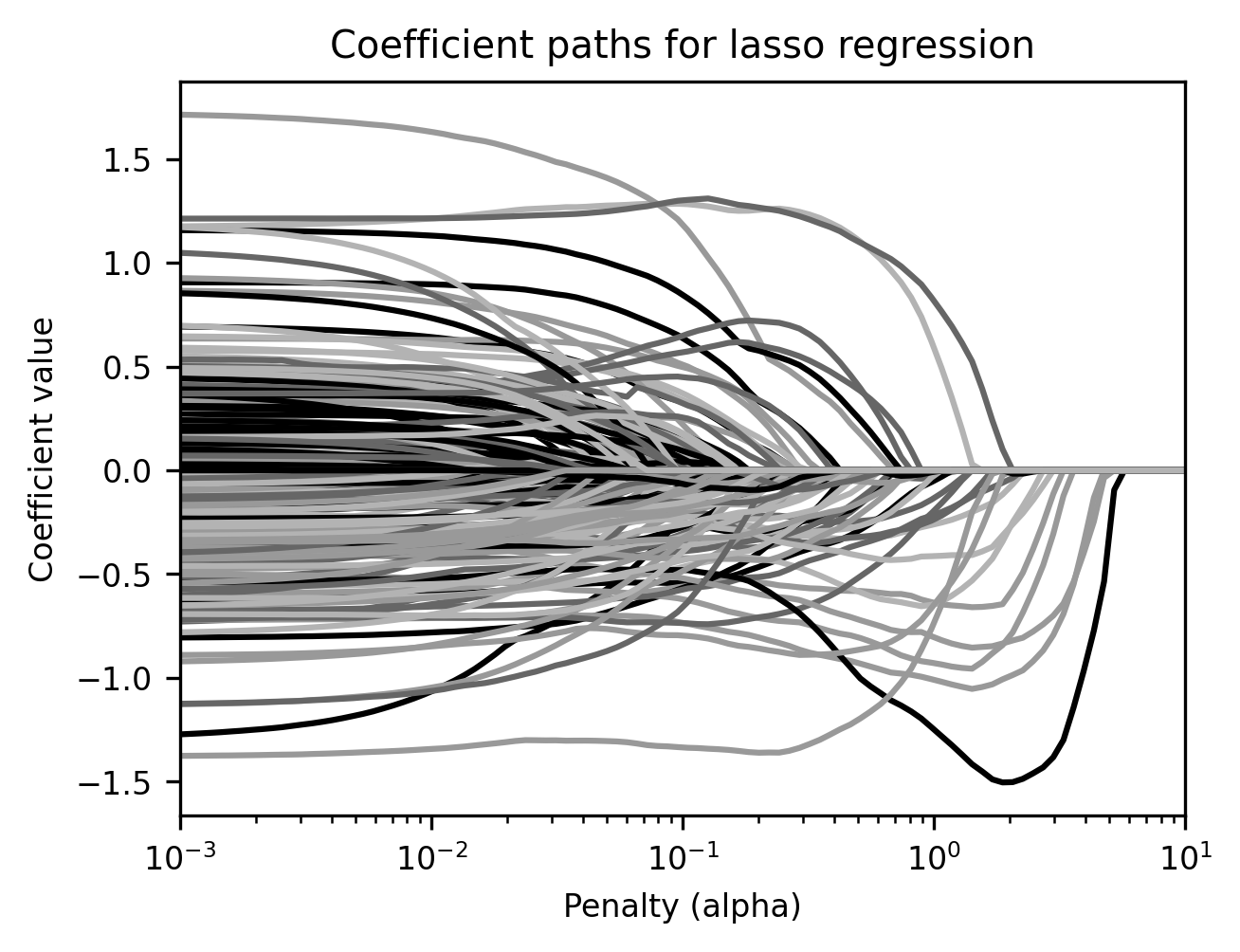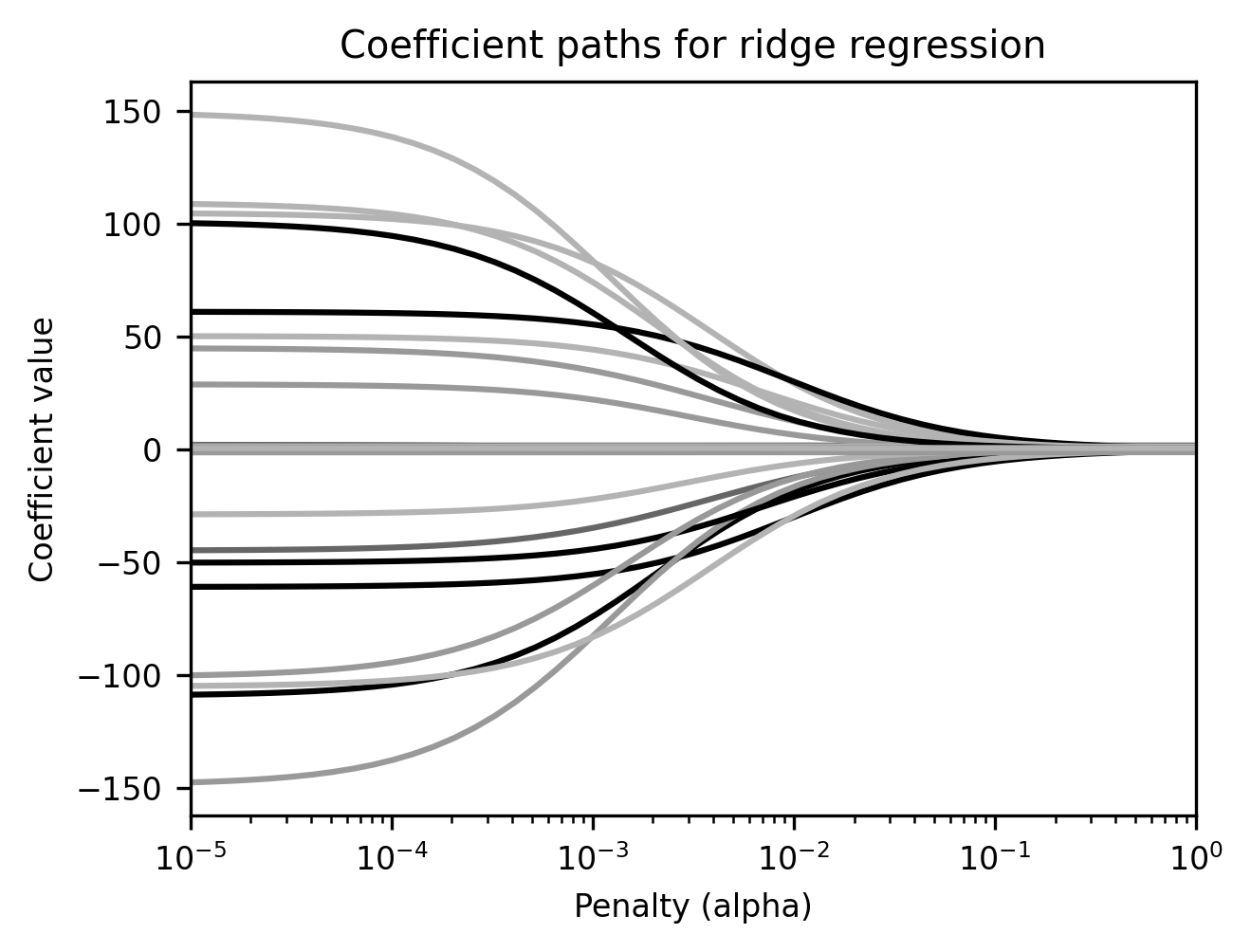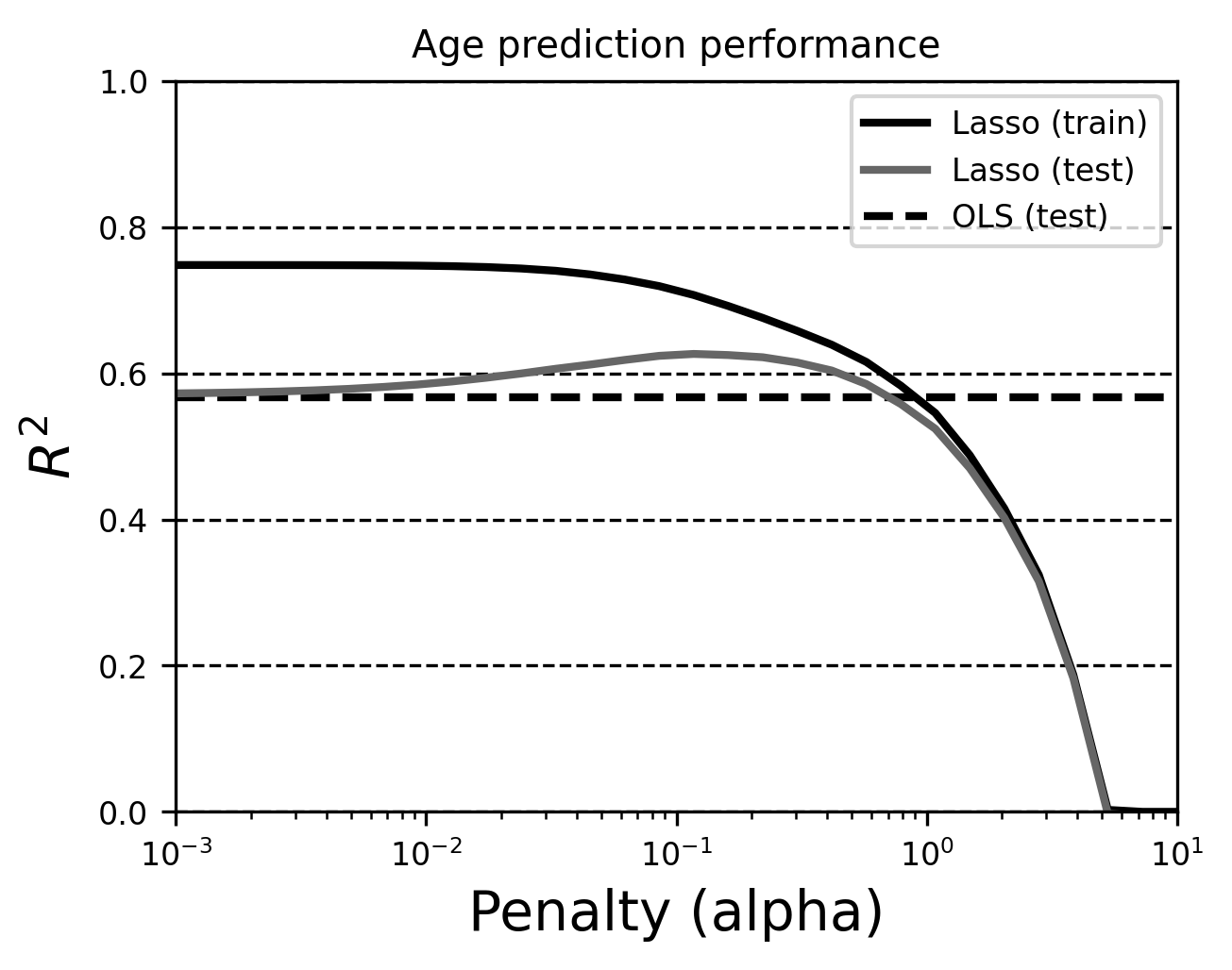Model selection
Contents
21. Model selection¶
Machine learning practitioners often emphasize the importance of having very large training datasets. It’s all well and good to say that if we want to make good predictions, we should collect an enormous amount of data; the trouble is that sometimes that’s not feasible. For example, if we’re neuroimaging researchers acquiring structural brain scans from people with an autism diagnosis, we can’t magically make tens of thousands of scans appear out of thin air. We may only be able to pool together one or two thousand data points, even with a monumental multi-site effort like the ABIDE initiative.
If we can’t get a lot more data, are there other steps we can take to improve our predictions? We’ve already seen how cross-validation methods can indirectly help us make better predictions by minimizing overfitting and obtaining better estimates of our models’ true generalization abilities. In this section, we’ll explore another general strategy for improving model performance: selecting better models.
21.1. Bias and variance¶
We’ve talked about the tradeoff between overfitting and underfitting, and the related tradeoff between flexibility and stability in estimation. Now we’ll introduce a third intimately-related pair of concepts: bias and variance. Understanding the difference between bias and variance, and why we can often trade one for the other, is central to developing good intuitions about when and how to select good estimators.
It’s probably easiest to understand the concepts of bias and variance through visual illustration. Here’s a classic representation:

Comparing the top and bottom rows gives us a sense of what we mean by variance: it’s the degree of scatter of our observations around their central tendency. In the context of statistical estimators, we say that an estimator has high variance if the parameter values it produces tend to vary widely over the space of datasets to which it could be applied. Conversely, a low-variance estimator tends to produce similar parameter estimates when applied to different datasets.
Bias, by contrast, refers to a statistical estimator’s tendency to produce parameter estimates that cluster in a specific part of the parameter space. A high-bias estimator produces parameter estimates that are systematically shifted away from the correct estimate—even as the size of the training dataset grows asymptotically. A low-bias estimator, conversely, will converge on the true parameter estimate as the sample size increases.
21.1.1. The bias-variance tradeoff¶
One interesting property of bias and variance is that they tend to trade off. That is, one can often decrease the variance of an estimator by deliberately increasing its bias or vice versa. To see this intuitively, imagine the extreme case of an estimator that always generates an identical prediction for all observations. Such an estimator would have low variance (actually, no variance) and extremely high bias. Conversely, an estimator that produces extremely variable estimates must be one capable of freely exploring various parts of parameter space—and hence, shows a weaker preference for, or bias towards, certain parts of the space.
This idea has a deep connection to the overfitting/underfitting and flexibility/stability distinctions we drew earlier. All three distinctions ultimately reflect the same core idea. A high-variance (low-bias) estimator is a flexible one that can identify a wide variety of patterns in the data; this also makes it more likely to overfit. Conversely, a high-bias (low-variance) estimator is a stable one that tends to produce similar parameter estimates no matter what data it’s presented with; such an estimator will frequently underfit because it lacks the flexibility needed to capture complex patterns in the data.
Neuroimaging researchers coming from a traditional scientific background often think of bias as a dirty word -— i.e., as something to be minimized at all costs. From a machine learning standpoint, however, there’s nothing intrinsically bad about bias. The bias of a particular model is nothing more than its systematic tendency to produce parameter estimates that cluster within a particular part of the space. Not only is this not a bad thing, but it’s often essential to producing good predictions. The bias of a given estimator – its tendency to give certain kinds of solutions – is often referred to as its inductive bias. The key question is then: to what degree does the inductive bias of a given estimator match the processes that give rise to our data?
In cases where there’s a match between an estimator and the data it’s applied to, a biased estimator will tend to perform better than a less biased one. Conversely, if an estimator has the wrong bias, it will tend to perform more poorly than an estimator with less bias.
This is a fairly abstract idea, so let’s make it concrete. Suppose you park your
car at the airport parking lot when you head off for a weekend vacation.
Consider two possible strategies you could use to find your car on your return.
First, you might rely on your memory of where you left the car; perhaps you
think you left it somewhere near that light pole over there in the B area of
the lot. Second, you could just randomly roam around the parking lot looking for
a car that looks like yours.
Which of these is the better car-finding strategy? Well, it depends! If you have a good memory, the high-bias strategy -— only searching within a particular part of the lot —- will lead you to your car more quickly than a random walk around the entire lot. But if your memory is poor, the biased strategy is likely to be counterproductive, because your car won’t be where you remember leaving it, no matter how much time you spend walking around that specific area. In the latter case, you would have been better off randomly walking around until you found your car.
21.2. Regularization¶
Our car parking example is a bit contrived, but it illustrates a core principle at the heart of good model selection: if we have useful prior knowledge about the domain, we should pick an estimator that builds that knowledge into its assumptions. For example, if we have a set of 1,000 potential features we could use in our model, but have good reason to believe that only a small fraction of those features make a meaningful contribution to the outcome variable, it seems like a good idea to use an estimator that can somehow select a subset of features. Using an estimator that acts as if all of our features are potentially important (as linear regression does) is likely to lead to overfitting.
The principle of introducing background knowledge into our model to improve predictions and prevent overfitting is known in machine learning and statistics as regularization. When we say we’re using a regularized estimator, what we’re typically saying is that we’ve taken an existing estimator (e.g., an OLS estimator) and constrained its behavior with additional information, so that it’s biased towards certain parts of the parameter space.
21.2.1. Penalized regression¶
To researchers who learned statistics in biomedical or social science training programs, it may be tempting to think of least-squares estimation as a kind of automatic default, with all other procedures requiring some special justification to use. But there’s nothing special about OLS. Well, it’s kind of special in that it always minimizes the squared error in our training sample. But as we’ve already seen, we usually care about minimizing test error, not training error (plus, sometimes we don’t want to quantify error in terms of a least-squares criterion). So if we can get our hands on an estimator that’s biased relative to OLS, but tends to reduce error in the test dataset, we probably still want to use it -— even if it doesn’t reduce error in the training data quite as well as OLS.
It turns out that there are many such estimators. One of the most widely used class of regularized estimators for regression problems is penalized regression. These methods generally start with garden variety OLS and then add a little twist in the form of a penalty parameter.
Consider the cost function we seek to minimize in OLS:
\(Cost = RSS = \sum^N_i(y_i - \sum^P_j\beta_jx_{ij})^2\)
Here, \(RSS\) is the residual sum of squares, \(N\) is the number of samples, and \(P\) is the number of features. Our goal is to obtain the set of \(\beta\) coefficients that minimize the \(RSS\).
Now consider a slight variation:
\(Cost = \sum^N_i(y_i - \sum^P_j\beta_jx_{ij})^2 + \alpha\sum^P_j|\beta_j|\)
The only difference here is that, in addition to the \(RSS\), our cost function includes a second term, \(\alpha\sum^P_j|\beta_j|\) -— the sum of absolute values of the \(\beta\) coefficients, weighted by the penalty parameter, \(\alpha\). The addition of the penalty parameter is the reason we refer to this variation on linear regression as penalized regression. The addition of the penalty may seem like a small change, but it has major consequences, which we’ll explore shortly.
The above form of penalized regression is known as lasso regression, and it’s very widely used. There’s also another very common form of penalized regression known as ridge regression. It looks a lot like lasso regression, except instead of computing the penalty as the sum of absolute coefficients, we take the sum of their squares:
\(Cost = \sum^N_i(y_i - \sum^P_j\beta_jx_{ij})^2 + \alpha\sum^P_j\beta_j^2\)
The difference between lasso and ridge regression may seem even smaller, but it again has important implications. Let’s explore the behavior of each of these methods.
21.2.1.1. Lasso regression¶
Let’s take the lasso first. Let’s think about what the addition of the penalty term to the standard RSS criterion does, conceptually. By making the overall cost depend on a (weighted) sum of absolute coefficients, we’re saying that there’s a certain cost to having large coefficients in our model. If the net negative contribution of a given feature to the RSS is smaller than its net positive contribution to the penalty, then it will be beneficial to “shrink” that feature’s coefficient to the point where the two terms perfectly cancel each other out. Thus, penalized regression biases the estimated regression coefficients by shrinking at least some of them.
For reasons outside the scope of our discussion here, the lasso doesn’t just shrink coefficients; it shrinks them to zero. That is, as we increase the penalty, more features drop out of our model, leaving us with a simpler prediction equation involving fewer features. For this reason, the lasso is often described as implicitly including a feature selection step.
To see how this works in practice, let’s return to our ABIDE-II data and
visualize what happens to our regression coefficients estimated with lasso
regression as we increase the penalty parameter. Here, we’ll plot the
coefficient paths: how each coefficient changes as \(\alpha\) changes
(judiciously picking a reasonable range of \(\alpha\) values). We’ve implemented
a plot_coef_path function that does this. Note also that we standardize our
features to mean-zero and unit-variance because lasso and ridge are sensitive
to scale.
from ndslib.viz import plot_coef_path
from ndslib.data import load_data
abide_data = load_data("abide2")
features = abide_data.filter(like='fs')
phenotypes = abide_data.iloc[:, :6]
from sklearn.linear_model import Lasso
from sklearn.preprocessing import scale
number_of_features = 200
X = scale(features.sample(number_of_features, axis=1, random_state=99))
y = phenotypes['age']
import numpy as np
alpha = np.logspace(-3, 1, 100)
ax = plot_coef_path(Lasso, X, y, alpha, max_iter=2000)
ax.set_title("Coefficient paths for lasso regression")
ax.set_xlim(1e-3, 10);

In the figure produced by the plot_coef_path helper function, each line
represents a different feature. We’re using 200 randomly selected features (from
the full set of 1,440) as predictors, so there are 200 lines. The x-axis
displays the penalty parameter used for lasso estimation; the y-axis displays
the resulting value of the coefficients. Notice how, at a certain point (around
alpha = 0.01), coefficients start to disappear. They’re not just small;
they’re gone (i.e., they’ve been “shrunk” to 0). This built-in feature
selection is a very useful property of the lasso. It allows us to achieve an
arbitrarily sparse solution simply by increasing the penalty.
21.2.1.2. Exercises¶
Change the
number_of_featuresvariable to be much larger (e.g., 400) or much smaller (e.g., 100). How are the coefficient paths affected by this change? Why do you think these changes happen?What happens if you use the site-residualized ages instead of the age variable?
Of course, as you know by now, there’s no free lunch in machine learning. There must be some price we pay for producing more interpretable solutions with fewer coefficients, right? There is. We’ll look at it in a moment; but first, let’s talk about ridge regression.
21.2.1.3. Ridge regression¶
Ridge regression, as noted above, is mathematically very similar to lasso regression. But it behaves very differently. Whereas the lasso produces sparse solutions, ridge regression, like OLS, always produces dense ones. Ridge does still shrink the coefficients (i.e., their absolute values get smaller as the penalty increases). It also pushes them towards a normal distribution. The latter property is the reason a well-tuned ridge regression model usually outperforms OLS: you can think of ridge regularization as basically a way of saying it may look like a few of the OLS coefficients are way bigger than others, but that’s probably a sign we’re fitting noise. In the real world, outcomes usually reflect the contributions of a lot of different factors. So let’s squash all of the extreme values towards zero a bit so that all of our coefficients are relatively small and bunched together.
from sklearn.linear_model import Ridge
# Coefficient paths for ridge regression, predicting age from 30 features
alpha = np.logspace(-5, 5, 100)
ax = plot_coef_path(Ridge, X, y, alpha)
ax.set_title("Coefficient paths for ridge regression")
ax.set_xlim(1e-5, 1);

It may look to the eye like the coefficients are shrinking all the way to zero as the penalty increases, but we promise you they aren’t. They may get very small, but unlike lasso regression, ridge coefficients will never shrink to nothing.
21.2.1.4. Effects of regularization on predictive performance¶
We’ve looked at two different flavors of penalized regression, and established that they behave quite differently. So, which one should we use? Which is the better regularization approach? Well, as with everything else it depends. If the process(es) that generated our data are sparse (or at least, have a good sparse approximation) -— meaning, a few of our features make very large contributions, and the rest don’t matter much —- then lasso regression will tend to perform better. If the data-generating process is dense—i.e., lots of factors make small contributions to the outcomes—then ridge regression will tend to perform better.
In practice, we rarely know the ground truth when working with empirical data. So we’re forced to rely on a mix of experience, intuition, and validation analyses.
Let’s do some of the latter here. To try to figure out what the optimal lasso
and ridge penalties are for our particular problem, we’ll make use of Scikit
Learn’s validation_curve utility, which allows us to quickly generate training
and testing performance estimates for an estimator as a function of one of its
parameters. As alluded to in Section 20, the validation_curve is
very similar to the learning_curve we’ve seen before, except that instead of
systematically varying the dataset size, we systematically vary one of the
estimator’s parameters (in this case, alpha). Let’s generate a validation
curve for lasso regression, still using 200 random features to predict age.
We’ll add OLS regression \(R^2\) for comparison and use our plot_train_test
helper function to visualize it.
from sklearn.model_selection import validation_curve, cross_val_score
from sklearn.linear_model import LinearRegression
from ndslib.viz import plot_train_test
x_range = np.logspace(-3, 1, 30)
train_scores, test_scores = validation_curve(
Lasso(max_iter=5000), X, y, param_name='alpha',
param_range=x_range, cv=5, scoring='r2')
ols_r2 = cross_val_score(
LinearRegression(), X, y, scoring='r2', cv=5).mean()
ax = plot_train_test(
x_range, train_scores, test_scores, 'Lasso',
hlines={'OLS (test)': ols_r2})
ax.set_title("Age prediction performance")
ax.set_xlim(1e-3, 10)
(0.001, 10)

Notice that, in the training dataset, \(R^2\) decreases monotonically as alpha increases. This is necessarily true (Why do you think that is? Hint: think of how \(R^2\) is defined, and its relationship to the least-squares component of the lasso cost function.)
In contrast, the error in the test dataset is lowest within a specific range of
alpha values. This optimum will vary across datasets, so you’ll almost always
need to tune the alpha parameter (e.g., using a validation curve like the one
above) to get the best performance out of your model. This extra degree of
complexity in the model selection process is one of the reasons you might not
want to always opt for a penalized version of OLS, even if you think it can
improve your predictions. If you muck things up and pick the wrong penalty, your
predictions could be way worse than OLS!
While we’ve only looked at one dataset, these are fairly typical results; in many application domains, penalized regression models tend to outperform OLS when using small to moderate-sized samples. When samples get very large relative to the number of features, the performance difference usually disappears. Outside of domains with extremely structured and high-dimensional data, this latter principle tends to be true more globally -— i.e., “more data usually beats better algorithms.”
21.2.1.5. Exercise¶
Use a similar approach to compare ridge regression with OLS.
21.3. Beyond linear regression¶
We’ve focused our attention here on lasso and ridge regression because they’re regularized versions of the OLS estimator most social scientists are already familiar with. But just as there’s nothing special about OLS, there’s also nothing special about (penalized) regression in general. There are many different estimators we could use to generate predictions. Each has its own inductive biases and will perform better on some datasets and worse on others. The science (or perhaps art) of machine learning lies in understanding the available estimators, data, and validation methods well enough to know how to tailor optimal (or at least good) machine learning workflows to the specific problem at hand. Let’s forge ahead with one more widely-used class of algorithms that differs quite a bit from the regression algorithms you’ve seen here so far.
21.3.1. Random forests¶
To illustrate how easy it is to try out completely different types of estimators
in Scikit-learn – and also draw attention to the fact that estimators based on
linear regression represent only a small part of the space–let’s repeat some of
our earlier regression analyses using a very different estimator: the
RandomForestRegressor. Random forests are essentially collections (or
ensembles) of decision trees. A decision tree is a structure for generating
classification (classification trees) or regression (regression trees)
predictions. Here’s an example of what a regression tree might look like if used
in our ABIDE-II dataset to try and predict age from structural brain features:

At each node, we evaluate a particular conditional. For example, the first question we ask is: is the subject’s observed value on the fsCT_218 variable less than or equal to 2.49, or is it greater? We follow the appropriate branch to the next node and answer the question we find there. We repeat this process until we reach a terminal node (or “leaf”), whereupon the tree produces the predicted value for that observation.
Random forests extend this idea by “bagging” multiple decision trees and
aggregating their outputs. Decision trees are very flexible and have the
propensity to overfit. By averaging over a lot of different trees (each one
generated by, e.g., resampling the data), we hopefully stabilize our predictions
and reduce overfitting. Random forests are popular because they’re extremely
powerful, their constituent trees are highly interpretable, and they tend to
perform well when we have a lot of data. The downsides are that being very
flexible, they have a tendency to overfit, and careful tuning may be required to
achieve good performance. They can also be quite slow, as performance tends to
improve with the number of decision trees. In the example below we will reduce
tree complexity and mitigate overfitting by performing an explicit feature
selection step before fitting the model. This is done using the SelectKBest
object and an f_regression criterion, which selects the \(k\) features that have
the strongest correlation with the target (based on an F-test – hence the
name). Ideally, we’d want to use a larger number of trees, but this would be very
slow, so we stick with a small number (10) for demonstration purposes (but
please do experiment with changing these numbers!)
from sklearn.ensemble import RandomForestRegressor
from sklearn.feature_selection import SelectKBest, f_regression
from ndslib.viz import plot_learning_curves
number_of_features = 50
alpha = 10
number_of_trees_in_forest = 10
selector = SelectKBest(f_regression, k=number_of_features)
X = selector.fit_transform(features, y)
estimators = [Ridge(alpha), RandomForestRegressor(number_of_trees_in_forest)]
labels = ["Ridge regression", "Random forests"]
plot_learning_curves(estimators, [X, X], y, [100, 200, 500, 900], labels)

In this case, the random forest estimator slightly outperforms ridge regression,
particularly as the sample size gets larger. But it’s worth reiterating our
earlier point: this isn’t some kind of law, or even a particularly good
heuristic; if you play with various parameters above (e.g.,
number_of_features, alpha, etc.), you can easily find regimes under which
ridge regression performs better.
21.3.1.1. Interpreting random forests¶
Unlike regression-based methods, decision trees (and hence random forests) don’t have linear coefficients. Instead, we can obtain feature importances, which tell us how important each feature is to the overall prediction (more important features are better at reducing uncertainty, and occur closer to the root of the tree). Let’s randomly sample 30 features and work with those. After fitting, we will print out the names of the 10 most important features.
rf = RandomForestRegressor(100)
X = features.sample(30, axis=1)
rf.fit(X, y)
import pandas as pd
print(pd.Series(
rf.feature_importances_, index=X.columns).sort_values(ascending=False).head(10))
fsCT_R_V2_ROI 0.272581
fsCT_R_MBelt_ROI 0.240108
fsCT_L_VMV2_ROI 0.044474
fsVol_L_PF_ROI 0.040136
fsCT_L_IP2_ROI 0.034641
fsVol_L_EC_ROI 0.028645
fsCT_L_a24pr_ROI 0.025200
fsVol_L_PeEc_ROI 0.023855
fsVol_R_2_ROI 0.022004
fsCT_R_LIPd_ROI 0.019635
dtype: float64
Be aware that there are some important subtleties related to the interpretation of feature importances, not least of which is that, as with any model, feature importances are configural: a feature may seem important when modeled alongside one set of other features, but unimportant when included with a different set of features.
21.3.1.2. Visualizing trees¶
We can also plot the individual decision trees. Note that different trees can often exhibit very different structures despite performing equally well predictively—an observation that should lead us to exercise caution when interpreting decision trees, even if they seem straightforward. In this particular case, as we saw above, a handful of features dominate the list of feature importances, so we might expect at least the first few nodes to look relatively similar. Let’s take a look at the first two trees in the forest.
from ndslib.viz import plot_graphviz_tree
plot_graphviz_tree(rf.estimators_[0], X.columns)

plot_graphviz_tree(rf.estimators_[2], X.columns)

21.3.2. Additional resources¶
To learn more about the properties of the lasso and ridge algorithms, we’d recommend reading an excellent tutorial by Ryan Tibshirani that Larry Wasserman amended and posted on his website. If you want to think a bit more about the implications of the \(\alpha\) parameter, particularly in ridge regression, you can read a paper that one of us wrote on the topic [Rokem and Kay, 2020].